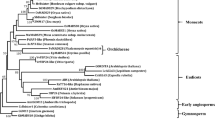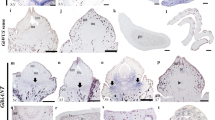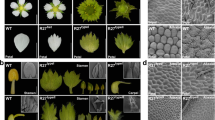Abstract
Carpels are essential for sexual plant reproduction because they house the ovules and subsequently develop into fruits that protect, nourish and ultimately disperse the seeds. The AGAMOUS (AG) gene is necessary for plant sexual reproduction because stamens and carpels are absent from ag mutant flowers1,2. However, the fact that sepals are converted into carpelloid organs in certain mutant backgrounds even in the absence of AG activity indicates that an AG-independent carpel-development pathway exists2. AG is a member of a monophyletic clade of MADS-box genes that includes SHATTERPROOF1 (SHP1), SHP2 and SEEDSTICK (STK)3, indicating that these four genes might share partly redundant activities. Here we show that the SHP genes are responsible for AG-independent carpel development. We also show that the STK gene is required for normal development of the funiculus, an umbilical-cord-like structure that connects the developing seed to the fruit, and for dispersal of the seeds when the fruit matures. We further show that all four members of the AG clade are required for specifying the identity of ovules, the landmark invention during the course of vascular plant evolution that enabled seed plants to become the most successful group of land plants4.
This is a preview of subscription content, access via your institution
Access options
Subscribe to this journal
Receive 51 print issues and online access
$199.00 per year
only $3.90 per issue
Buy this article
- Purchase on Springer Link
- Instant access to full article PDF
Prices may be subject to local taxes which are calculated during checkout




Similar content being viewed by others
References
Bowman, J. L., Smyth, D. R. & Meyerowitz, E. M. Genes directing flower development in Arabidopsis. Plant Cell 1, 37–52 (1989)
Bowman, J. L., Smyth, D. R. & Meyerowitz, E. M. Genetic interactions among floral homeotic genes of Arabidopsis. Development 112, 1–20 (1991)
Theissen, G. et al. A short history of MADS-box genes in plants. Plant Mol. Biol. 42, 115–149 (2000)
Stewart, W. N. & Rothwell, G. W. Paleobotany and the evolution of plants (Cambridge Univ. Press, 1993)
Drews, G. N., Bowman, J. L. & Meyerowitz, E. M. Negative regulation of the Arabidopsis homeotic gene AGAMOUS by the APETALA2 product. Cell 65, 991–1002 (1991)
Alvarez, J. & Smyth, D. R. CRABS CLAW and SPATULA, two Arabidopsis genes that control carpel development in parallel with AGAMOUS. Development 126, 2377–2386 (1999)
Savidge, B., Rounsley, S. D. & Yanofsky, M. F. Temporal relationship between the transcription of two Arabidopsis MADS box genes and the floral organ identity genes. Plant Cell 7, 721–733 (1995)
Flanagan, C. A., Hu, Y. & Ma, H. Specific expression of the AGL1 MADS-box gene suggests regulatory functions in Arabidopsis gynoecium and ovule development. Plant J. 10, 343–353 (1996)
Heisler, M. G. B., Atkinson, A., Bylstra, Y. H., Walsh, R. & Smyth, D. R. SPATULA, a gene that controls development of carpel margin tissues in Arabidopsis, encodes a bHLH protein. Development 128, 1089–1098 (2001)
Liljegren, S. J. et al. SHATTERPROOF MADS-box genes control seed dispersal in Arabidopsis. Nature 404, 766–770 (2000)
Mizukami, Y. & Ma, H. Ectopic expression of the floral homeotic gene AGAMOUS in transgenic Arabidopsis plants alters floral organ identity. Cell 71, 119–131 (1992)
Rounsley, S. D., Ditta, G. S. & Yanofsky, M. F. Diverse roles for MADS box genes in Arabidopsis development. Plant Cell 7, 1259–1269 (1995)
Ma, H., Yanofsky, M. F. & Meyerowitz, E. M. AGL1-AGL6, an Arabidopsis gene family with similarity to floral homeotic and transcription factor genes. Genes Dev. 5, 484–495 (1991)
Angenent, G. C. et al. A novel class of MADS box genes is involved in ovule development in Petunia. Plant Cell 7, 1569–1582 (1995)
Colombo, L. et al. The Petunia MADS box gene FBP11 determines ovule identity. Plant Cell 7, 1859–1868 (1995)
Western, T. L. & Haughn, G. W. BELL1 and AGAMOUS genes promote ovule identity in Arabidopsis thaliana. Plant J. 18, 329–336 (1999)
Blazquez, M. A., Soowal, L. N., Lee, I. & Weigel, D. LEAFY expression and flower initiation in Arabidopsis. Development 124, 3835–3844 (1997)
Sessions, A., Weigel, D. & Yanofsky, M. F. The Arabidopsis thaliana MERISTEM LAYER 1 promoter specifies epidermal expression in meristems and young primordia. Plant J. 20, 259–263 (1999)
Wisman, E., Cardon, G. H., Fransz, P. & Saedler, H. The behaviour of the autonomous maize transposable element En/Spm in Arabidopsis thaliana allows efficient mutagenesis. Plant Mol. Biol. 37, 989–999 (1998)
Kempin, S. A. et al. Targeted disruption in Arabidopsis. Nature 389, 802–803 (1997)
Kunst, L., Klenz, J. E., Martinezzapater, J. & Haughn, G. W. AP2 gene determines the identity of perianth organs in flowers of Arabidopsis thaliana. Plant Cell 1, 1195–1208 (1989)
Yanofsky, M. F. et al. The protein encoded by the Arabidopsis homeotic gene AGAMOUS resembles transcription factors. Nature 346, 35–39 (1990)
Acknowledgements
We thank A. Ray for advice on scanning electron microscopy, D. Weigel for providing the pDW137 vector, members of Yanofsky laboratory for comments, and H. Chang and P. Golshani for technical assistance. A.P. received a scholarship from the Ananda Mahidol Foundation, and this work was supported by a grant from the National Science Foundation (to M.Y.).
Author information
Authors and Affiliations
Corresponding author
Ethics declarations
Competing interests
The authors declare that they have no competing financial interests.
Supplementary information
Rights and permissions
About this article
Cite this article
Pinyopich, A., Ditta, G., Savidge, B. et al. Assessing the redundancy of MADS-box genes during carpel and ovule development. Nature 424, 85–88 (2003). https://doi.org/10.1038/nature01741
Received:
Accepted:
Issue Date:
DOI: https://doi.org/10.1038/nature01741
This article is cited by
-
Hormonal Regulation of Ovule Initiation in Arabidopsis
Journal of Plant Growth Regulation (2024)
-
Arabidopsis TCP4 transcription factor inhibits high temperature-induced homeotic conversion of ovules
Nature Communications (2023)
-
Maternal control of triploid seed development by the TRANSPARENT TESTA 8 (TT8) transcription factor in Arabidopsis thaliana
Scientific Reports (2023)
-
Whole-mount RNA in situ hybridization technique in Torenia ovules
Plant Reproduction (2023)
-
Cloning and Expression Analysis of Onion (Allium cepa L.) MADS-Box Genes and Regulation Mechanism of Cytoplasmic Male Sterility
Biochemical Genetics (2023)
Comments
By submitting a comment you agree to abide by our Terms and Community Guidelines. If you find something abusive or that does not comply with our terms or guidelines please flag it as inappropriate.



